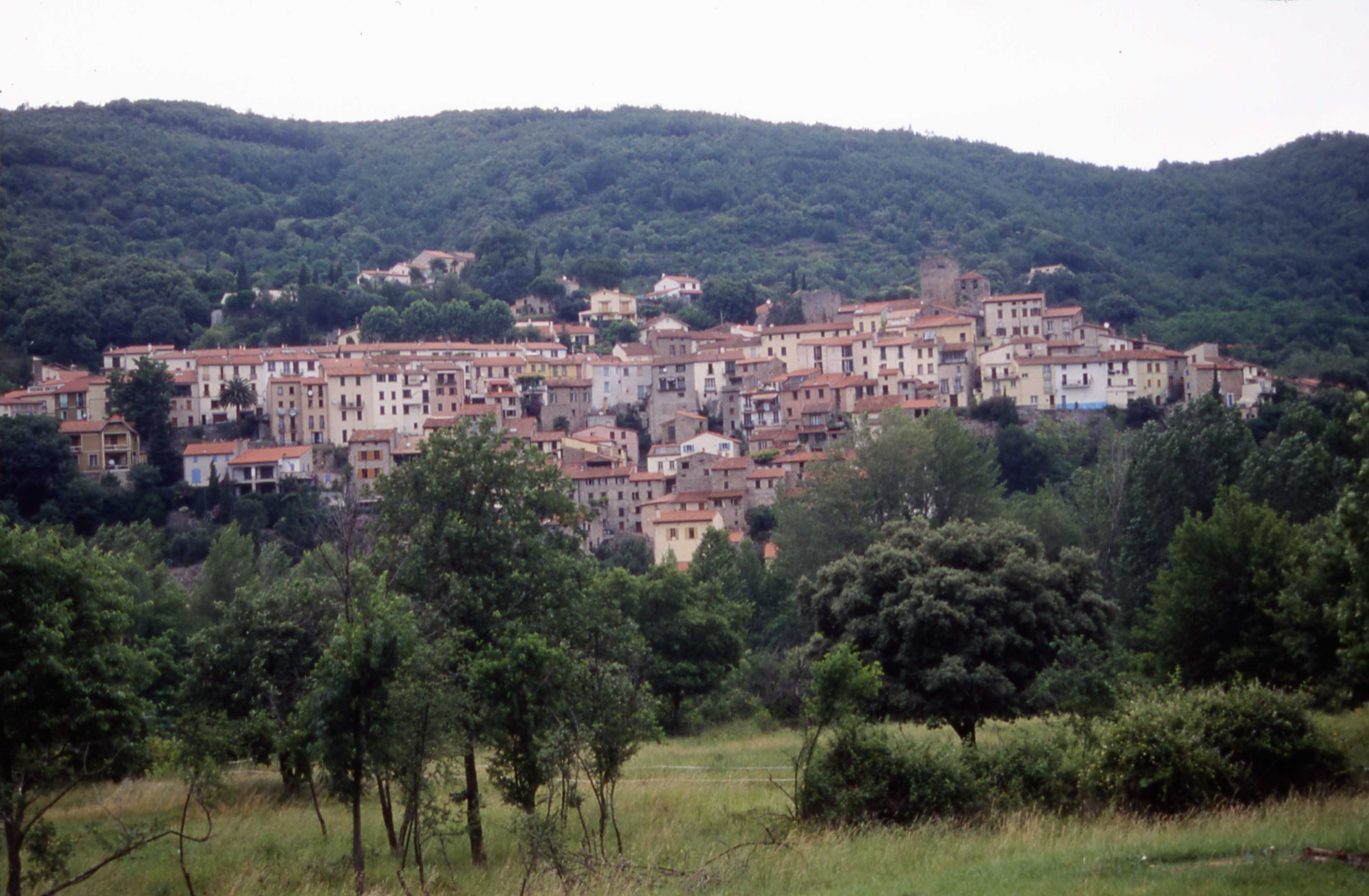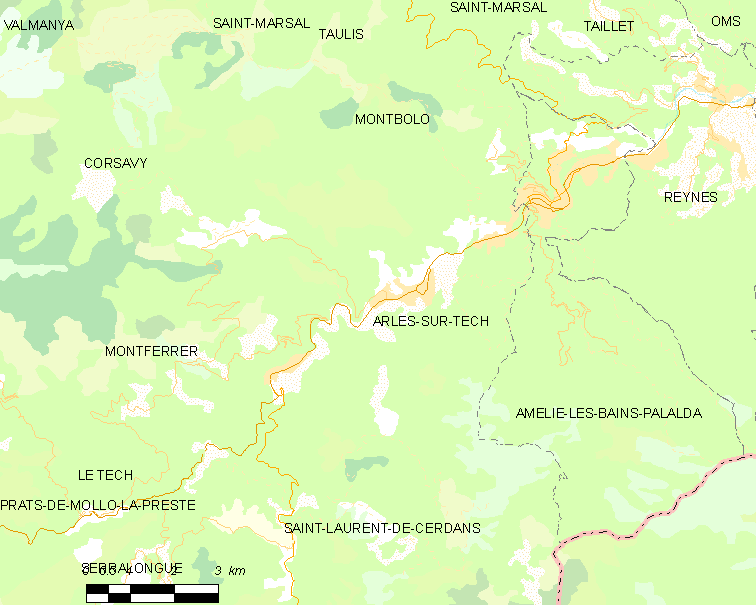|
Amélie-les-Bains-Palalda
Amélie-les-Bains-Palalda (; ca, Els Banys i Palaldà) is a commune in the Pyrénées-Orientales department in southern France. Prior to 1942, it was known as Amélie-les-Bains. It is situated in the Tech valley, and combines the old and the new with a mix of narrow cobbled streets and modern accommodation. It has become a 'station verte' meaning that it must strive at all times to ensure that tourists benefit from a calm and natural environment. Geography Location Amélie-les-Bains-Palalda is located in the canton of Le Canigou and in the arrondissement of Céret. It sits at the confluence of the Mondony with the Tech, SSW of Perpignan by road. The town is situated at a height of and has both a winter and summer season. Climate In the winter season the average temperature is about 10 degrees Celsius, and in the summer it is roughly 29 degrees Celsius. Thunderstorms are not infrequent in the area, and the telltale signs are small showers throughout the day. Springs ... [...More Info...] [...Related Items...] OR: [Wikipedia] [Google] [Baidu] |
Communes Of The Pyrénées-Orientales Department
The Pyrénées-Orientales department is composed of 226 communes. Most of the territory (except for the district of Fenolheda) formed part of the Principality of Catalonia until 1659, and Catalan is still spoken (in addition to French) by a significant minority of the population. The Catalan names of communes are taken from the ''Enciclopèdia catalana'' and are intended for comparison with the official French names: they do not indicate the current or former linguistic status of the commune. List of intercommunalities The communes cooperate in the following intercommunalities (as of 2020):BANATIC Périmètre des EPCI à fiscalité propre. Accessed 3 July 2020. * |
Palalda
Palalda is a former commune in Pyrénées-Orientales, now part of Amélie-les-Bains-Palalda. Geography Palalda is located above the river Tech (river), Tech, to the northeast of Amélie-les-Bains and to the east of Montbolo. History The first mention of Palalda is from the year 814, as being the western limit of the territory of Céret. On 1 October 1942, the commune of Palalda is linked to Amélie-les-Bains to create the new commune of Amélie-les-Bains-Palalda. Politics and administration Canton In 1790, Palalda is included in the canton of Arles-sur-Tech, canton of Arles, which remains the same after being united to Amélie-les-bains in 1942.Jean-Pierre Pélissier, Paroisses et communes de France : dictionnaire d'histoire administrative et démographique, vol. 66 : Pyrénées-Orientales, Paris, CNRS, 1986 Mayors Demography ;Ancien Régime Population under the Ancien Régime is calculated either in number of ''feu fiscal'' (''f'', fire tax), or in number of inh ... [...More Info...] [...Related Items...] OR: [Wikipedia] [Google] [Baidu] |
Arles-sur-Tech
Arles-sur-Tech (, literally ''Arles on Tech''; ca, Arles de Tec) is a commune in the Pyrénées-Orientales department in southern France. Geography Location Arles-sur-Tech is located in the canton of Le Canigou and in the arrondissement of Céret. Arles-sur-Tech is situated in the southernmost valley in mainland France before Spain, the Vallespir, through which the long river "Tech" flows. This small town is surrounded by the eastern Pyrenees which dominate the skyline around Arles-sur-Tech. The town sits on the only main road which passes through the valley, the D 115, making it accessible from Spain in the west and the plane of Roussillon and Perpignan in the east. It is located close to the larger and more well-known spa town of Amélie-les-Bains-Palalda. History At the end of the Spanish Civil War Arles-sur-Tech was the site of a camp housing Republican escapees from Spain. It was used as an initial sorting camp. Government and politics Mayors International ... [...More Info...] [...Related Items...] OR: [Wikipedia] [Google] [Baidu] |
Canton Of Le Canigou
The canton of Le Canigou is an administrative division of the Pyrénées-Orientales department, in southern France. It was created at the French canton reorganisation which came into effect in March 2015. Its seat is in Amélie-les-Bains-Palalda. It consists of the following communes: #Amélie-les-Bains-Palalda #Arles-sur-Tech # Baillestavy # La Bastide #Boule-d'Amont #Bouleternère #Casefabre #Casteil #Corneilla-de-Conflent #Corsavy #Coustouges # Espira-de-Conflent # Estoher #Fillols # Finestret #Fuilla # Glorianes # Joch #Lamanère #Mantet #Marquixanes #Montbolo #Montferrer #Prats-de-Mollo-la-Preste #Prunet-et-Belpuig # Py #Reynès # Rigarda #Rodès #Sahorre #Saint-Laurent-de-Cerdans #Saint-Marsal #Saint-Michel-de-Llotes # Serralongue # Taillet # Taulis #Taurinya #Le Tech #Valmanya #Vernet-les-Bains #Vinça Vinça (; ca, Vinçà) is a commune in the Pyrénées-Orientales department in southern France. Geography Vinça is located in the canton of Le Canigou and in the ... [...More Info...] [...Related Items...] OR: [Wikipedia] [Google] [Baidu] |
Maçanet De Cabrenys
Maçanet de Cabrenys is a municipality in the ''comarca'' of Alt Empordà, Girona, Catalonia, Spain. It also belongs to the ''subcomarca'' of Alta Garrotxa. It includes the villages of Arnera, Les Creus, Les Mines, Les Salines, Tapis, Els Vilars, and Oliveda. It is situated at the foot of the Eastern Pyrenees, with the Rivers Arnera and Frausa. It has numerous springs, which makes it attractive for tourism, the largest source of revenue, together with dryland farming and animal husbandry. It has a water bottling facility. The center (370 m) is located in a valley between the two highest points of the municipal territory, the ''Puig de Les Salines'' (1331 m) and the ''roc de Frausa'' (1445 m). History Last century, near the river Arnera there were found neolitical axe, together with the menhir called La Pedra Dreta. Those findings show that the valley of the Arnera was populated from prehistoric periods. The first documented mention of the place appears in the precept of Louis the ... [...More Info...] [...Related Items...] OR: [Wikipedia] [Google] [Baidu] |
Arrondissement Of Céret
The arrondissement of Céret is an arrondissement of France in the Pyrénées-Orientales department (Northern Catalonia) in the Occitanie region. It has 64 communes. Its population is 129,464 (2016), and its area is . Composition The communes of the arrondissement of Céret, and their INSEE codes, are: # L'Albère (66001) # Alénya (66002) # Amélie-les-Bains-Palalda (66003) # Argelès-sur-Mer (66008) # Arles-sur-Tech (66009) # Bages (66011) # Banyuls-dels-Aspres (66015) # Banyuls-sur-Mer (66016) # La Bastide (66018) # Le Boulou (66024) # Brouilla (66026) # Caixas (66029) # Calmeilles (66032) # Camélas (66033) # Castelnou (66044) # Cerbère (66048) # Céret (66049) # Les Cluses (66063) # Collioure (66053) # Corneilla-del-Vercol (66059) # Corsavy (66060) # Coustouges (66061) # Elne (66065) # Fourques (66084) # Lamanère (66091) # Laroque-des-Albères (66093) # Latour-Bas-Elne (66094) # Llauro (66099) # Maureillas-las-Illas (66106) # Montauriol (66112) # Montbolo (66113) # Mon ... [...More Info...] [...Related Items...] OR: [Wikipedia] [Google] [Baidu] |
Tech River
The Tech (; ca, Tec ) is a river in southern France, very close to the French-Spanish border. It runs through a valley in the Pyrénées-Orientales, in the former Roussillon, and is long. Its source is the Parcigoule Valley, elevation , and it feeds the Mediterranean Sea. At Céret, the medieval ''Devil's bridge'', once the largest bridge arch in the world, spans the river in an arc of in length. Geography The Tech flows through 25 different towns, from its source to the sea: Prats-de-Mollo-la-Preste, Serralongue, Le Tech, Saint-Laurent-de-Cerdans, Montferrer, Corsavy, Arles-sur-Tech, Montbolo, Amélie-les-Bains-Palalda, Reynès, Céret, Saint-Jean-Pla-de-Corts, Maureillas-las-Illas, Le Boulou, Tresserre, Saint-Génis-des-Fontaines, Montesquieu-des-Albères, Banyuls-dels-Aspres, Villelongue-dels-Monts, Brouilla, Ortaffa, Palau-del-Vidre, Elne and Argelès-sur-Mer. It flows into the Mediterranean Sea between Saint-Cyprien and Argelès-sur-Mer, southeast of Perpignan Perpig ... [...More Info...] [...Related Items...] OR: [Wikipedia] [Google] [Baidu] |
Montbolo
Montbolo (; ca, Montboló) is a commune in the Pyrénées-Orientales department in southern France. Geography Localization Montbolo is located in the canton of Le Canigou and in the arrondissement of Céret. Geology Montbolo once had gypsum mines, used for making plaster, and also lutite and dolomite. A landslide in a gypsum stone-pit in Montbolo occurred on 20 March 1886 and killed three workers. Population Sites of interest The Saint-Andrew church of Montbolo was first built in the 12th century and then modified in the 13th, 14th and 17th centuries. At the end of the 19th century, works started for a full repair of the church, but the new roof was entirely destroyed following a storm in January 1900. Other repairs have been made more recently, such as the rebuild of the portal, which destroyed some of the older elements. Montbolo has two dolmens: the Caixa de Rotllan, on the city limit with Arles-sur-Tech and the dolmen de Formentera. File:Montbolo Egli ... [...More Info...] [...Related Items...] OR: [Wikipedia] [Google] [Baidu] |
Pierre Restany
Pierre Restany (24 June 1930 – 29 May 2003), was an internationally known French art critic and cultural philosopher. Restany was born in Amélie-les-Bains-Palalda, Pyrénées-Orientales, and spent his childhood in Casablanca. On returning to France in 1949 he attended the Lycée Henri-IV before studying at universities in France, Italy and Ireland. From their first meeting in 1955, Restany maintained a strong tie with Yves Klein (to whom is attributed Klein-blue). Conceptions of New Realism / Nouveau Realisme In 1960 Pierre Restany created the idea and coined the term Nouveau Réalisme with Yves Klein during a group show in the Apollinaire gallery in Milan. It was an idea that united a group of French and Italian artists. Nouveau Realisme was the European answer to the American Neo-Dada of Fluxus and Pop Art. The group included Martial Raysse, Arman, Yves Klein, François Dufrene, Raymond Hains, Daniel Spoerri, Jean Tinguely, Jacques Villeglé - and was later joined by ... [...More Info...] [...Related Items...] OR: [Wikipedia] [Google] [Baidu] |
Communes Of France
The () is a level of administrative division in the French Republic. French are analogous to civil townships and incorporated municipalities in the United States and Canada, ' in Germany, ' in Italy, or ' in Spain. The United Kingdom's equivalent are civil parishes, although some areas, particularly urban areas, are unparished. are based on historical geographic communities or villages and are vested with significant powers to manage the populations and land of the geographic area covered. The are the fourth-level administrative divisions of France. vary widely in size and area, from large sprawling cities with millions of inhabitants like Paris, to small hamlets with only a handful of inhabitants. typically are based on pre-existing villages and facilitate local governance. All have names, but not all named geographic areas or groups of people residing together are ( or ), the difference residing in the lack of administrative powers. Except for the municipal arrondi ... [...More Info...] [...Related Items...] OR: [Wikipedia] [Google] [Baidu] |
Spain
, image_flag = Bandera de España.svg , image_coat = Escudo de España (mazonado).svg , national_motto = ''Plus ultra'' (Latin)(English: "Further Beyond") , national_anthem = (English: "Royal March") , image_map = , map_caption = , image_map2 = , capital = Madrid , coordinates = , largest_city = Madrid , languages_type = Official language , languages = Spanish language, Spanish , ethnic_groups = , ethnic_groups_year = , ethnic_groups_ref = , religion = , religion_ref = , religion_year = 2020 , demonym = , government_type = Unitary state, Unitary Parliamentary system, parliamentary constitutional monarchy , leader_title1 = Monarchy of Spain, Monarch , leader_name1 = Felipe VI , leader_title2 = Prime Minister of Spain ... [...More Info...] [...Related Items...] OR: [Wikipedia] [Google] [Baidu] |
Saint-Laurent-de-Cerdans
Saint-Laurent-de-Cerdans (; ca, Sant Llorenç de Cerdans) is a commune in the Pyrénées-Orientales department in southern France. Geography Saint-Laurent-de-Cerdans is located in the canton of Le Canigou and in the arrondissement of Céret. Government and politics Mayors Population See also *Communes of the Pyrénées-Orientales department The Pyrénées-Orientales department is composed of 226 communes. Most of the territory (except for the district of Fenolheda) formed part of the Principality of Catalonia until 1659, and Catalan is still spoken (in addition to French) by a si ... References Communes of Pyrénées-Orientales {{PyrénéesOrientales-geo-stub ... [...More Info...] [...Related Items...] OR: [Wikipedia] [Google] [Baidu] |




_by_Erling_Mandelmann.jpg)
